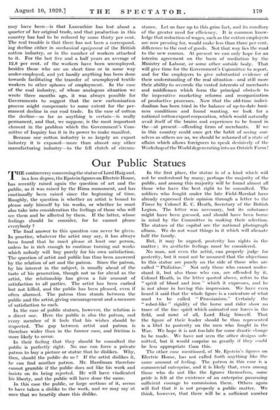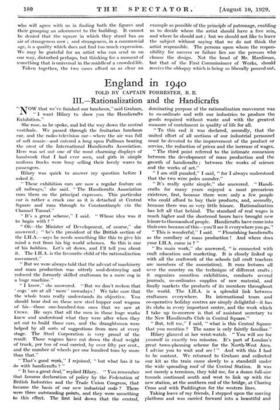Our Public Statues T HE controversy concerning the statue of Lord
Haig and, in a less degree, the Epstein figures on Electric House, has recently raised again the question of art and the public, as it was raised by the Rima monument, and has continually been raised since the beginning of time. Roughly, the question is whether an artist is bound to please only himself by his works, or whether he must also take into consideration the feelings of those who will see them and be affected by them. If the latter, whose feelings should he consider, for he cannot please everybody ?
The final answer to this question can never be given. In practice, whatever the artist may say, it has always been found that he must please at least one person, unless he is rich enough to continue turning out works which nobody will buy purely for his own satisfaction. The question of artist and public has thus been answered by the relation of art and the patron. Since the patron, by his interest in the subject, is usually ahead of the taste of his generation, though not so far ahead as the artist, the relationship has given a fair amount of satisfaction to all parties. The artist has been curbed but not killed, and the public has been pleased, even if often alarmed. The patron thus stands between the public and the artist, giving encouragement and a measure of satisfaction to each.
In the case of public statues, however, the relation is a direct one. Here the public is also the patron, and every member of it feels that his wishes should be respected. The gap between artist and patron is therefore wider than in the former case, and friction is more likely to occur.
In their feeling that they should be consulted the public is perfectly right. No one can force a private patron to buy a picture or statue that he dislikes. Why, then, should the public do so ? If the artist dislikes it, he can find another patron. Mr. Hardiman therefore cannot grumble if the public does not like his work and insists on its being rejected. He will have vindicated his liberty, and the public will have done the same.
In this case the public, or large sections of it, seems to have taken a dislike to the work, and we may say at once that we heartily share this dislike. In the first place, the statue is of a kind which will not be understood by many, perhaps the majority of the public, and among this majority will be found almost all those who have the best right to be consulted. The soldiers who fought under the late Field-Marshal have already expressed their opinion through a letter to the Times by Colonel E. C. Heath, Secretary of the British Legion. The letter was necessary, but its substance might have been guessed, and should have been borne in mind by the Committee in making their selection. The statues of the capital are the national photograph album. We do not want things in it which will alienate half the family.
But, it may be argued, posterity has rights in the matter ; its aesthetic feelings must be considered.
No man, not even the artist, can properly judge for posterity, but it must not be assumed that the objections to this statue are purely on the side of those who are called "Philistine." Not only those who cannot under- stand it, but also those who can, are offended by it. Colonel Heath, in the letter quoted above, refers to the "spirit of blood and iron " which it expresses, and he is not alone in having this impression. We have even heard it said that the whole figure is a caricature of what used to be called " Prussianism." Certainly the " robot-like " rigidity of the horse and rider show no trace of the fine spirit which animated our forces in the field, and most of all, Lord Haig himself. That the figure of their leader should be thus represented is a libel to posterity on the men who fought in the War. We hope it is not too late for some drastic change to be made. We have not seen the other designs sub- mitted, but it would surprise us greatly if they could be less appropriate than this.
The other case mentioned, of Mr. Epstein's figures on Electric House, has not called forth anything like the same amount of feeling. The patron in this case is a commercial enterprise, and it is likely that, even among those who do not like the figures themselves, some pride is felt at the existence of an enterprise possessing sufficient courage to commission them. Others again will feel that it is not properly a public matter. We think, however, that there Will be a sufficient number who will agree with us in finding both the figures and their grouping an adornment to the building. It cannot be denied that the square in which they stand has an air of strangeness now ; and strangeness, in a commercial age, is a quality which does not find too much expression. We may be grateful for an artist who can send us on our way, disturbed perhaps, but thinking for a moment of something that is universal in the middle of a crowded life.
Taken together, the two cases afford us as clear an example as possible of the principle of patronage, enabling us to decide where the artist should have a free rein, and where he should not ; but we should not like to leave the subject without saying that we do not think the artist responsible. The persons upon whom the respon- sibility for success or failure lies are the persons who choose the design. Not the head of Mr. Hardiman, but that of the First Commissioner of Works, should receive the obloquy which is being so liberally poured out.

































 Previous page
Previous page